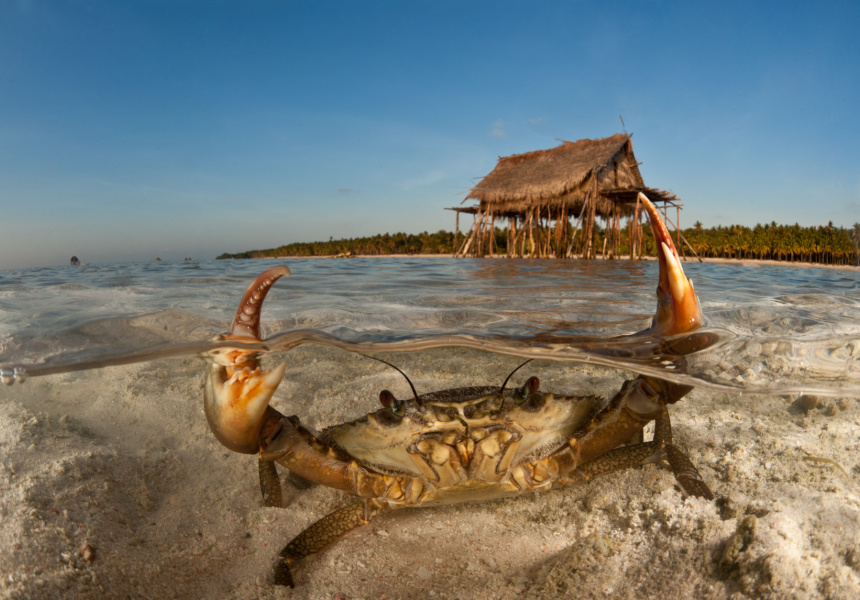Imagine sitting on the wet ground of a tropical rainforest at night, with leeches crawling all around you. That’s what photographer Juergen Freund, with his wife and collaborator Stella Chiu-Freund, did to capture a stunning, almost surreal image of bioluminescent fungi hugging a tree truck.
“You could feel everything that crawls up your leg,” Freund says. But the pair’s patience paid off – the resulting image was highly commended in the 2021 Wildlife Photographer of the Year competition.
Recently, the couple put themselves into an even more precarious position in order to photograph a nest of banded sea kraits in Fiji’s Great Sea Reef.
“I knew quite well how they would behave,” says Freund of the snakes. “If you don’t know that, it could get you into trouble because they’re highly venomous. You really have to know certain animals. Not everything is a butterfly.”
Again, the risk was worth it: the image is now on display at the annual Wildlife Photographer of the Year exhibition at the Australian National Maritime Museum in Sydney. On loan from London’s Natural History Museum and running through October, the striking exhibition collects more than 100 images of plants and animals from all over the planet.
Freund is a veteran, of both the competition and nature photography in general. After getting his first camera at age 18 and immediately pursuing bugs and beetles in his native Germany, he learned how to scuba dive in nearby lakes so he could master the art of underwater photography. By the mid-1990s, he was working full-time as a freelance nature photographer. He eventually settled in Tropical North Queensland with Chiu-Freund, relishing their handy perch near the Great Barrier Reef.
While his job might sound loaded with risk, Freund rarely finds himself directly in harm’s way. Even when capturing sharks on film, he has remained calm and careful. But he does point out that anyone aspiring to photograph nature must start out with a deep love of the often unpredictable arena that is the great outdoors.
“It’s a passion,” he says. “Either you like to be in nature or you don’t. You have to be willing to be uncomfortable, because that’s when you get the shots. It’s very rarely that you can get the cool stuff in comfort. If you’re willing to do that and spend the time, everything will follow.”
Over the four decades that he’s been shooting in nature, Freund has learnt many valuable tricks of the trade. That includes how to create split-shot images depicting both underwater and topside scenes, and how to overlay multiple shots into one final image. The latter technique, called “focus stacking”, helped create that mesmerising photo of the glowing mushrooms. It took eight separate shots captured over an hour and a half to achieve the components of the completed image, whereas a single shot would have only caught a sliver of the mushroom-laden tree in the desired sharpness.
Keeping up with rapidly changing technology is crucial to being a professional photographer. Freund has used a Nikon camera exclusively for decades, but has continued to update the model as they’ve evolved. His other key piece of advice for aspiring shutterbugs is to concentrate on what resonates with you personally. And if you do want to focus on nature, you don’t have to look far.
Freund’s work is appearing at the annual Wildlife Photographer of the Year exhibition, held at the Australian National Maritime Museum in Sydney until October 31. As part of his showing, he’ll also speak as part of The Glen Grant Photography Masterclass Series, a four-part series featuring some of the best photographers with works on display.
“Wherever you live, there will be an opportunity,” he says. “You don’t have to go diving. [Even] if you want to do it as a hobby, it’s one of the best things you can do. It gets you out of the house and brings you into nature. You’re breathing fresh air. It can’t get any better than that.”
Freund has now been all around the world shooting in the wild, though he hasn’t yet made it to Africa. But considering he recently photographed colourful swarms of budgies and went diving with giant cuttlefish a few days later, he is quite satisfied with the natural contrasts on offer in Australia.
“I wonder then, is it not better to just spend more time in the field here?” he asks. “Because it’s such a big continent, with such a variety of species. There’s no end to it really.”
This article is produced by Broadsheet in partnership with The Glen Grant. The Glen Grant is an events partner for associated events with the Wildlife Photographer of The Year exhibition at the Australian National Maritime Museum.

